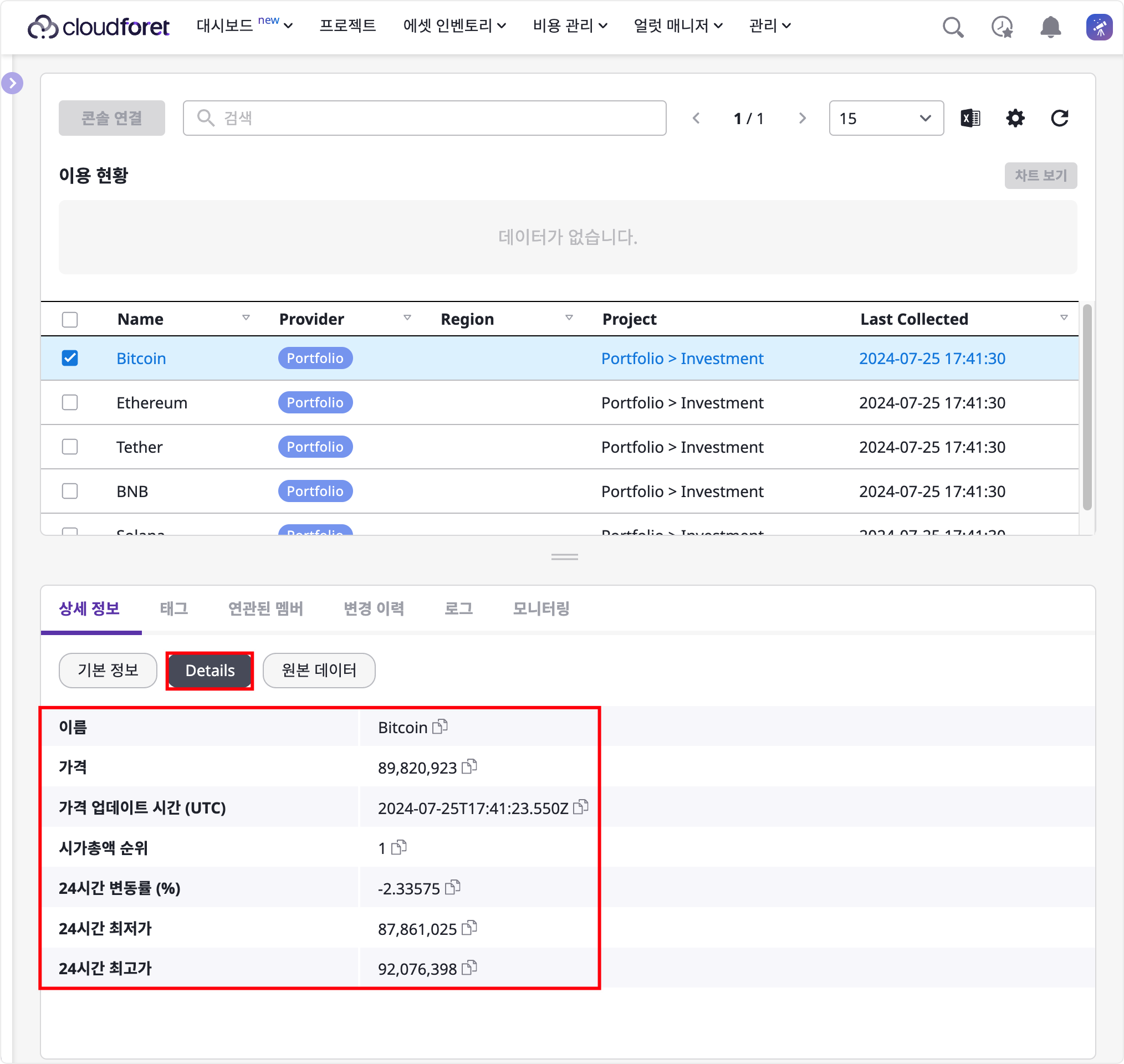Registering Inventory Plugin
This document guides you through registering and testing a developed SpaceONE plugin.
1. Environment Setup
Before registering the plugin, the following environment setup is required.
1) Endpoint Configuration
1-1) To register an Inventory plugin, you need gRPC endpoints for Identity, Inventory, and Repository services.
The added service endpoints are as follows:
api_key: eyJ...
endpoints:
plugin: grpc://localhost:50051
identity: grpc://localhost:8083
inventory: grpc://localhost:8084
repository: grpc://localhost:80852) Port Forwarding
Port forwarding allows gRPC communication with each microservice in the local environment.
If issues occur, you can close the ports with the following command:
kill $(ps aux | grep 'kubectl port-forward' | awk '{print $2}')If you’ve terminated all ‘kubectl port-forward’ related processes with the above command,
Please refer to Port Forwarding | Installing SpaceONE to reconfigure port forwarding for Console, Console API, and Console API V2 microservices, and then reconfigure the port forwarding for Identity, Inventory, and Repository services that we set up above.
Port forwarding is needed for a total of 6 microservices.
2-1) Now that you’ve completed port forwarding for all 6 microservices, let’s check the available API list once.
The result of this command is as follows. You can check the available API list for each microservice with this command.
Service | Resource | Short Names | Verb
------------+----------------------+-------------------------+-----------------------------------------------------------------------------------------------------------------------------------------
plugin | Health | | Check, Watch
plugin | ServerInfo | | get_version
plugin | Collector | | init, verify, collect
plugin | Job | | get_tasks
identity | Health | | Check, Watch
identity | ServerInfo | | get_version
identity | APIKey | api_key | create, enable, disable, delete, get, list, stat
identity | Authorization | | verify
identity | Domain | domain | create, update, change_auth_plugin, update_plugin, verify_plugin, delete, enable, disable, get, list, stat, get_public_key
identity | DomainOwner | | create, update, delete, get
identity | Endpoint | endpoint | list
identity | Policy | policy | create, update, delete, get, list, stat
identity | Project | project | create, update, delete, get, list, stat, add_member, modify_member, remove_member, list_members
identity | ProjectGroup | project_group, pg | create, update, delete, get, list, stat, add_member, modify_member, remove_member, list_members, list_projects
identity | Provider | provider | create, update, delete, get, list, stat
identity | Role | role | create, update, delete, get, list, stat
identity | RoleBinding | role_binding, rb | create, update, delete, get, list, stat
identity | ServiceAccount | service_account, sa | create, update, delete, get, list, stat
identity | Token | token | issue, refresh
identity | User | user | create, update, verify_email, confirm_email, reset_password, set_required_actions, enable, disable, delete, get, list, stat, find, sync
inventory | Health | | Check, Watch
inventory | ServerInfo | | get_version
inventory | ChangeHistory | change_history | list, stat
inventory | CloudService | cloud_service, cs | create, update, delete, get, list, analyze, stat
inventory | CloudServiceQuerySet | cloud_service_query_set | create, update, delete, run, test, enable, disable, get, list, stat
inventory | CloudServiceStats | cloud_service_stats | list, analyze, stat
inventory | CloudServiceType | cloud_service_type, cst | create, update, delete, get, list, stat
inventory | Collector | collector | create, update, update_plugin, verify_plugin, delete, get, list, stat, collect
inventory | CollectorRule | collector_rule, cr | create, update, change_order, delete, get, list, stat
inventory | Job | | delete, get, list, analyze, stat
inventory | JobTask | | delete, get, list, stat
inventory | Note | note | create, update, delete, get, list, stat
inventory | Region | region | create, update, delete, get, list, stat
inventory | ResourceGroup | | create, update, delete, get, list, stat
repository | Health | | Check, Watch
repository | ServerInfo | | get_version
repository | Plugin | plugin | register, update, deregister, enable, disable, get_versions, get, list, stat
repository | Policy | | create, update, delete, get, list, stat
repository | Repository | repository, repo | register, update, deregister, get, list, stat
repository | Schema | | create, update, delete, get, list, statFor more detailed API information, please refer to Cloudforet API .
2. Repository Registration
1) Repository Check
You can confirm that Managed Repository exists. Managed Repository is the default repository provided by SpaceONE. Create a new repository for registering the plugin on your local machine.
repository_id | name | repository_type | created_at
-----------------+--------------------+-------------------+--------------------------
repo-managed | Managed Repository | managed | 2024-07-15T04:14:07.640Z
Count: 1 / 12) Repository Registration
---
repository_type: local
name: Local RepositoryThe result of registering repository is as follows.
---
created_at: '2024-07-25T16:22:58.162Z'
name: Local Repository
repository_id: repo-16a1409f9992
repository_type: local2-2) Now, if you check the repository again, you can see that Local Repository has been registered. The repository_id is generated as a hash value.
- The
repository_idvalue is different for each user.
repository_id | name | repository_type | created_at
-------------------+--------------------+-------------------+--------------------------
repo-managed | Managed Repository | managed | 2024-07-15T04:14:07.640Z
repo-16a1409f9992 | Local Repository | local | 2024-07-25T16:22:58.162Z
Count: 2 / 23. Schema Creation
Schema provides templates for entering Secret Data in SpaceONE Console.
1) Schema Check
Before creating a schema for Local Repository, check what schemas exist in Managed Repository.
Managed Repository Schema Check
name | service_type
-----------------------------------------+--------------------
aws_access_key | secret.credentials
aws_assume_role | secret.credentials
azure_client_secret | secret.credentials
azure_client_secret_for_cost_management | secret.credentials
azure_credentials | secret.credentials
azure_subscription_id | secret.credentials
google_cloud_project_id | secret.credentials
google_oauth2_credentials | secret.credentials
spaceone_api_key | secret.credentials
telegram_auth_token | secret.credentials
Count: 10 / 10Now, let’s create a new schema for Local Repository.
2) Schema Creation
2-1) If you check the schema for the repository_id generated, you can see that there is no schema created yet.
NO DATA2-2) The YAML specification for creating a new schema in Local Repository is as follows.
---
name: portfolio_investment_schema
service_type: secret.credentials
schema:
properties:
investment_type:
minLength: 4.0
title: Investment Type
type: string
required:
- investment_type
type: object
labels:
- Investment
tags:
description: Investment CredentialsLocal Repository Schema is created.
---
created_at: '2024-07-25T16:25:31.180Z'
domain_id: domain-9998b2bc254d
labels:
- Investment
name: portfolio_investment_schema
repository_info:
name: Local Repository
repository_id: repo-16a1409f9992
repository_type: local
schema:
properties:
investment_type:
minLength: 4.0
title: Investment Type
type: string
required:
- investment_type
type: object
service_type: secret.credentials
tags:
description: Investment Credentials
updated_at: '2024-07-25T16:25:31.180Z'4. Provider Creation
As mentioned in Service Account, SpaceONE provides 3 CSPs (AWS, Azure, GCP) by default.
Since the plugin developed in the example collects data based on price standards, it is a bit different from CSP. However, the default Provider is the resource indicating where the collected data comes from.
That is, if data exists, you can group the data by what type of Provider.
1) Provider Check
You can check the current registered providers, which are the default providers AWS, Azure, Google Cloud.
provider | name | order
--------------+--------------+---------
aws | AWS | 1
google_cloud | Google Cloud | 2
azure | Azure | 3
Count: 3 / 32) Provider Creation
First, let’s create a YAML specification needed to register a Provider.
---
provider: portfolio
name: Portfolio
tags:
icon: https://www.svgrepo.com/show/195329/mortgage-insurance.svg
label: Portfolio
template:
service_account:
schema:
properties:
amount:
minLength: 4.0
title: Asset
type: string
required:
- amount
type: object
capability:
supported_schema:
- portfolio_investment_schema
metadata:
view:
layouts:
help:service_account:create:
name: Creation Help
options:
markdown:
en: "# Getting Started with Portfolio
Easily manage and track your assets through Portfolio.
## Portfolio Type
Please enter the type of asset. (e.g., savings account, stocks, cryptocurrency)
"
ko: "# Portfolio 시작 가이드
Portfolio를 통해 자산을 쉽게 관리하고 추적하세요.
## Portfolio 타입
어떤 종류의 자산인지 입력해주세요. (적금, 주식, 암호 화폐 등)
"The result of registering Provider is as follows.
---
capability:
supported_schema:
- portfolio_investment_schema
created_at: '2024-07-25T16:28:53.209Z'
domain_id: domain-9998b2bc254d
metadata:
view:
layouts:
help:service_account:create:
name: Creation Help
options:
markdown:
en: '# Getting Started with Portfolio
Easily manage and track your assets through Portfolio.
## Portfolio Type
Please enter the type of asset. (e.g., savings account, stocks, cryptocurrency) '
ko: '# Portfolio 시작 가이드
Portfolio를 통해 자산을 쉽게 관리하고 추적하세요.
## Portfolio 타입
어떤 종류의 자산인지 입력해주세요. (적금, 주식, 암호 화폐 등) '
name: Portfolio
order: 10
provider: portfolio
tags:
icon: https://www.svgrepo.com/show/195329/mortgage-insurance.svg
label: Portfolio
template:
service_account:
schema:
properties:
amount:
minLength: 4.0
title: Asset
type: string
required:
- amount
type: object2-3) If you check the provider again, you can see that portfolio has been added.
provider | name | order
--------------+--------------+---------
aws | AWS | 1
google_cloud | Google Cloud | 2
azure | Azure | 3
portfolio | Portfolio | 10
Count: 4 / 42-4) And in the cloud service, you can also see a provider named ‘Portfolio’.

5. Service Account Creation
SpaceONE Service Account functions as follows:
- Through Service Account and Project resources, you can group collected resources from the outside and manage them.
- Service Account means the collection unit of the plugin.
For example, if there is a Provider named Investment, you can create Service Accounts under Investment, and manage them by grouping them with the Portfolio project created in Project Creation.
Click the Portfolio item in Service Account and click the [+ Add] button to create a Service Account.
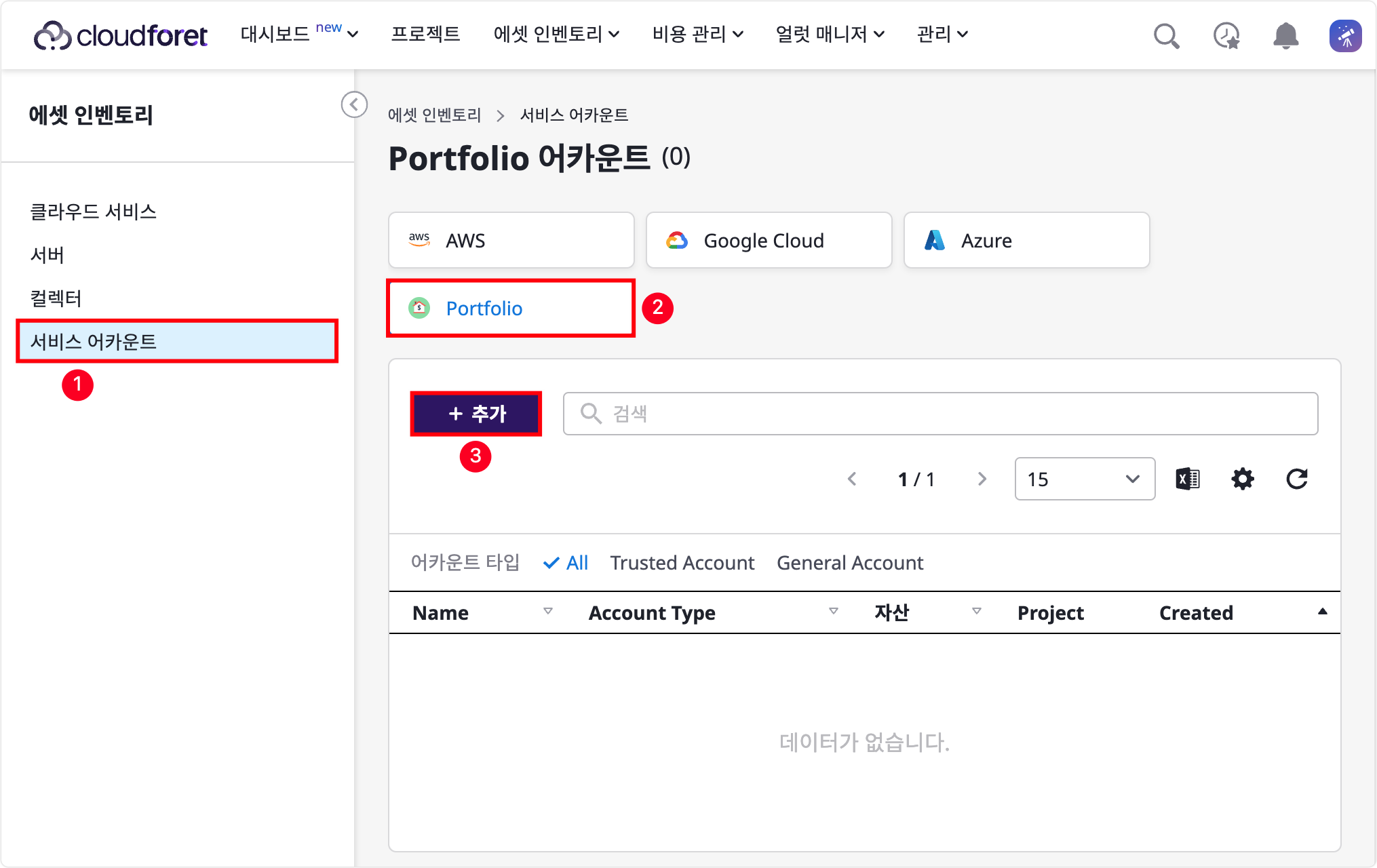
You can see the YAML specification as it is in the
create_provider.yamlfile.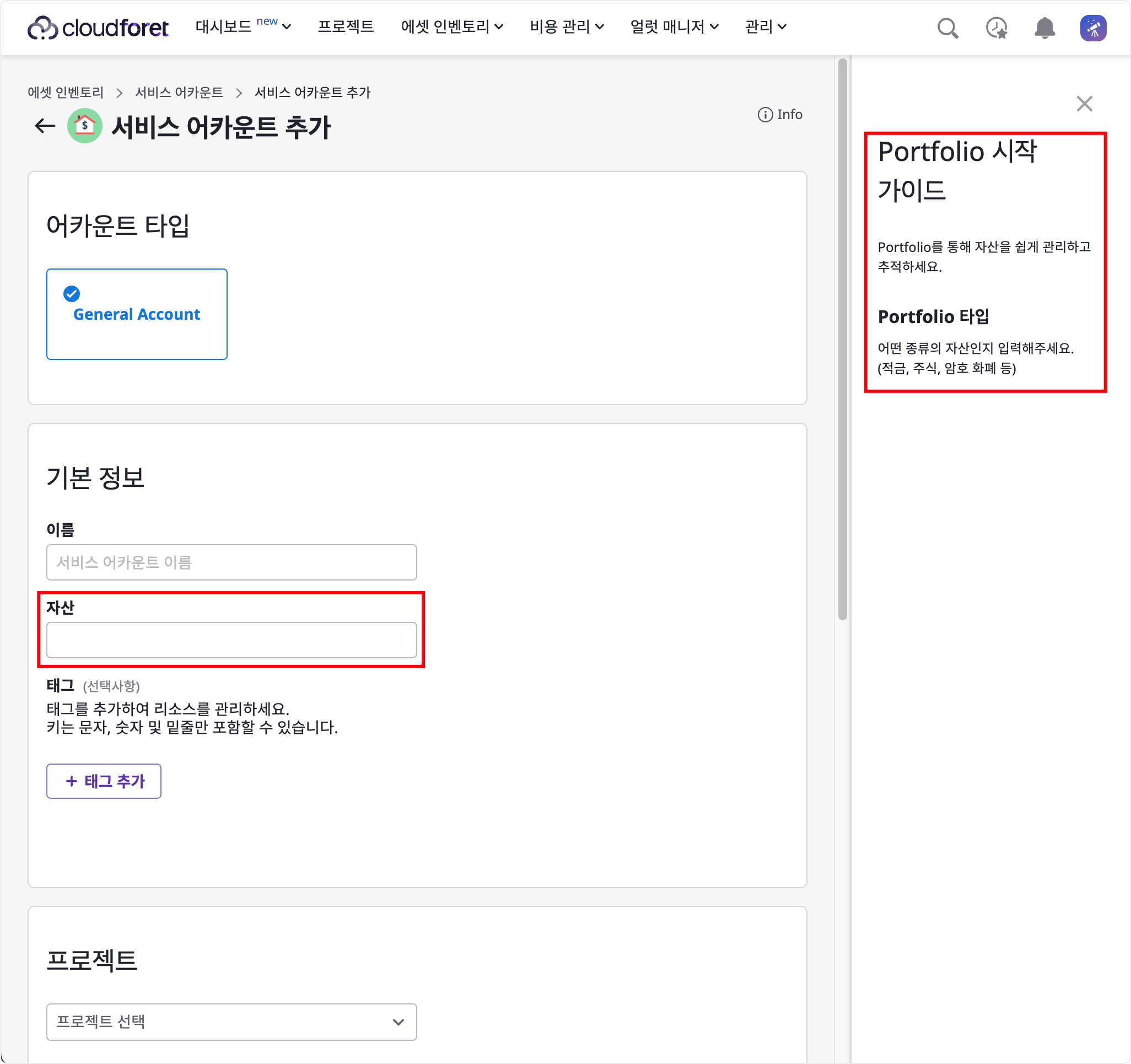
Add the Service Account for the example developed, entering the name and asset as in the YAML specification. Fill in the rest of the information.
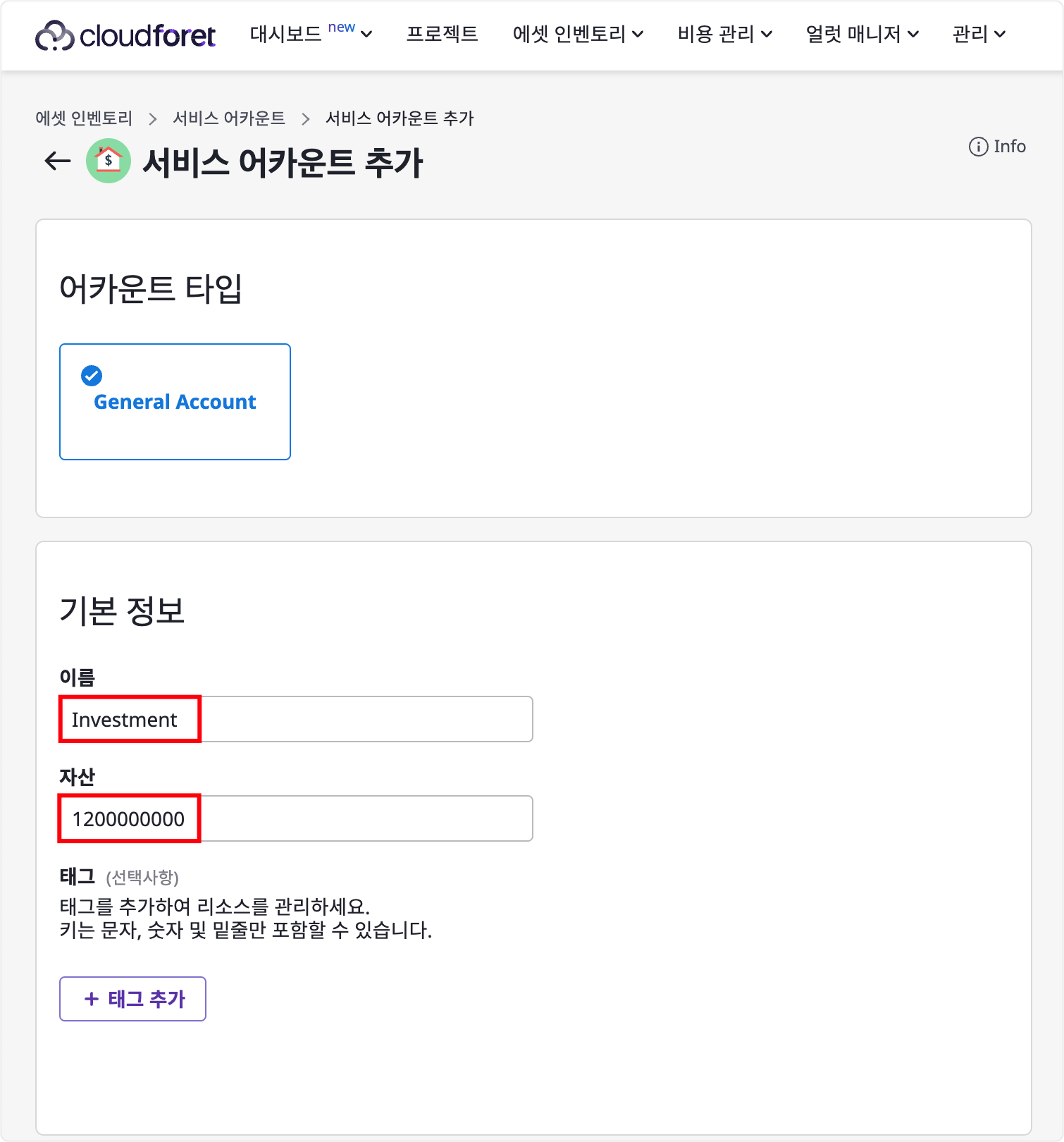
- The name (name) is a default value.
- The asset is the value defined in
template > service_account > schema > properties > amountincreate_provider.yaml.
- Select the Portfolio project group in the project.
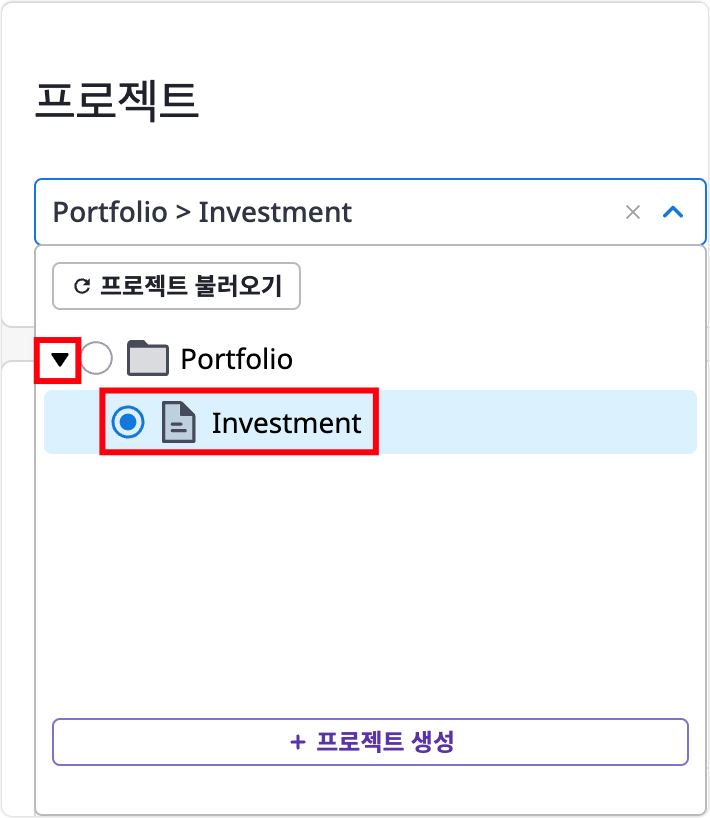
Click [Add] to create the Investment Service Account.

The Investment Service Account is created correctly.
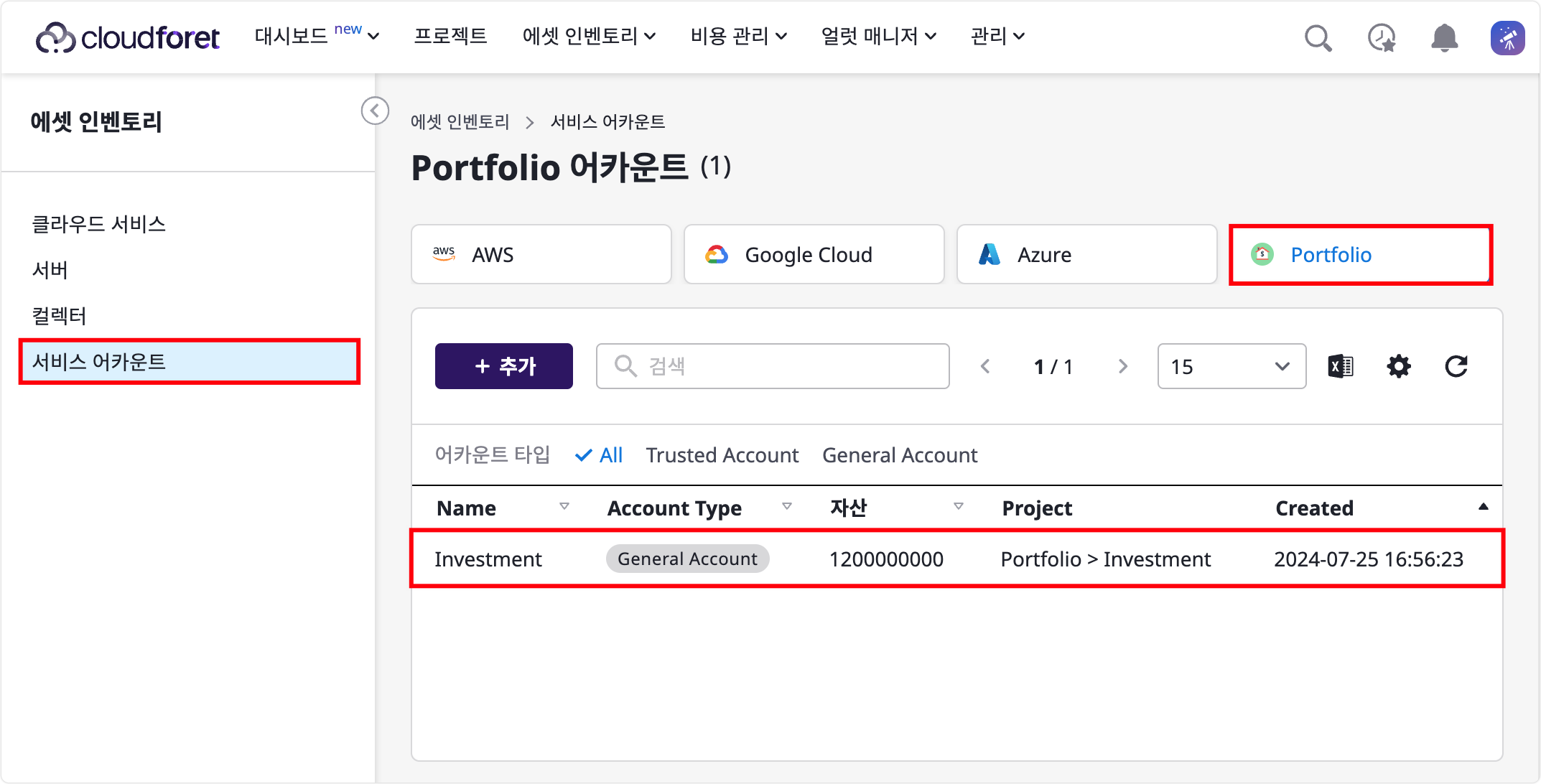
6. Plugin Registration
Registering an Inventory plugin allows you to view the data collected by the plugin in SpaceONE. At this time, you use the Collector resource.
1) Collector Resource Check
Currently, there is no collector (Collector) registered in the provider of Local Repository.
NO DATA1-1) If you check in the console UI, you can see that there is no collector.
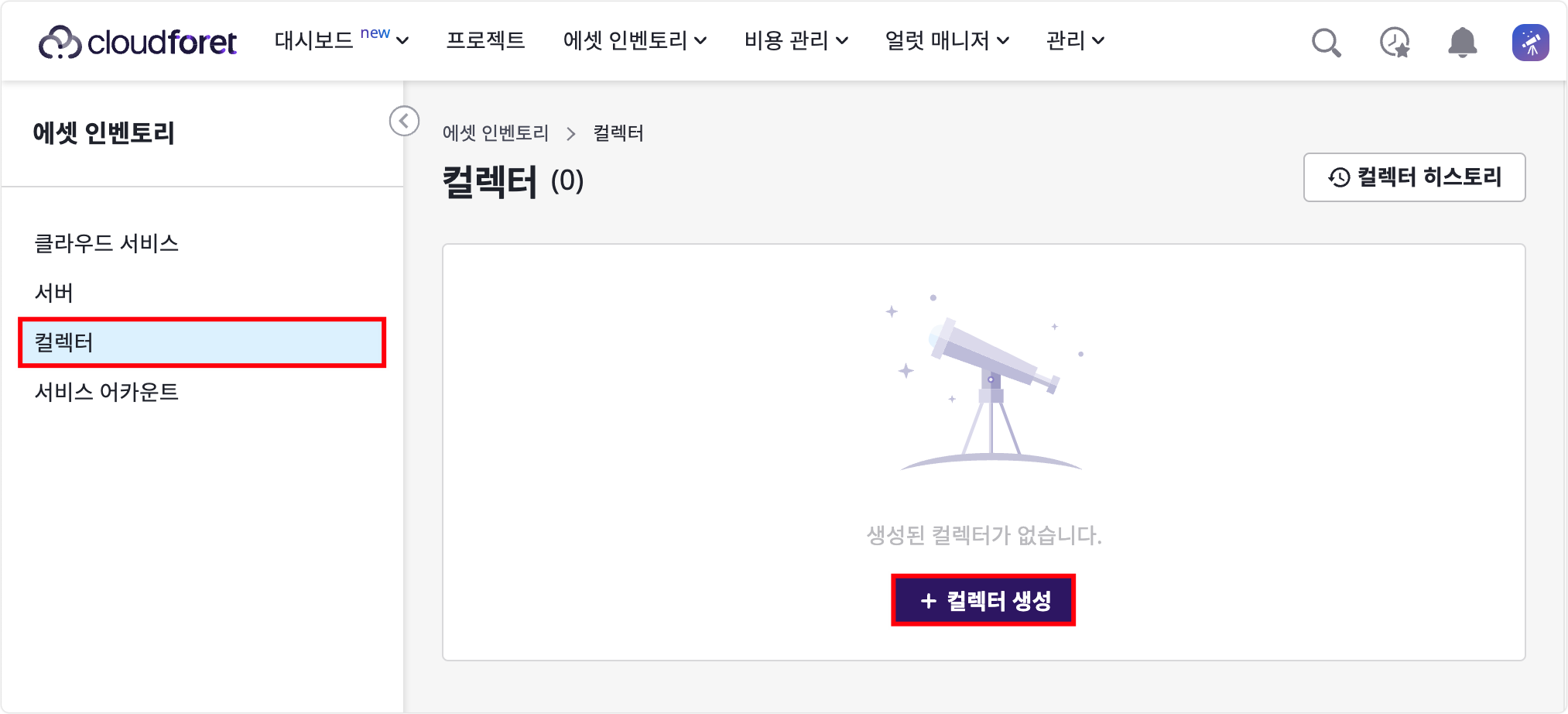
1-2) If you click the Create Collector, you can see that there is no collector in the ‘Investment’ provider that you registered in Local Repository.
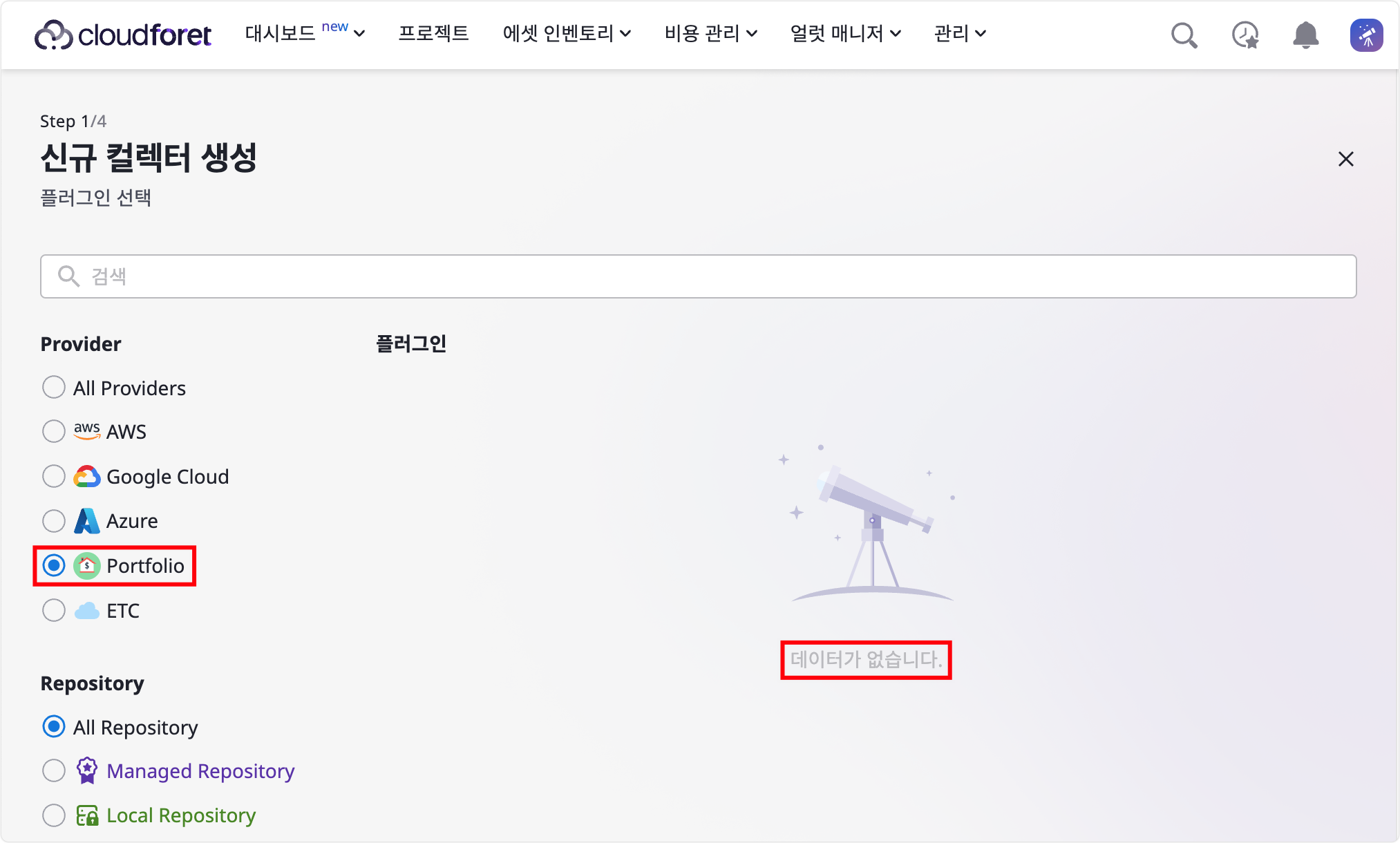
2) setup.py Writing
2-1) Create a VERSION file.
2-2) Write a Python package list for plugin execution.
spaceone-api
pre-commit
pycoingecko
grpcio2-3) Write setup.py file.
#
# Copyright 2020 The SpaceONE Authors.
#
# Licensed under the Apache License, Version 2.0 (the "License");
# you may not use this file except in compliance with the License.
# You may obtain a copy of the License at
#
# http://www.apache.org/licenses/LICENSE-2.0
#
# Unless required by applicable law or agreed to in writing, software
# distributed under the License is distributed on an "AS IS" BASIS,
# WITHOUT WARRANTIES OR CONDITIONS OF ANY KIND, either express or implied.
# See the License for the specific language governing permissions and
# limitations under the License.
from setuptools import find_packages, setup
with open("VERSION", "r") as f:
VERSION = f.read().strip()
f.close()
setup(
name="plugin-portfolio-inven-collector",
version=VERSION,
description="SpaceONE Portfolio Inventory Collector Plugin",
long_description="",
url="https://www.spaceone.dev/",
author="MEGAZONE SpaceONE Team",
author_email="admin@spaceone.dev",
license="Apache License 2.0",
packages=find_packages(),
install_requires=[
"spaceone-api",
"pycoingecko",
],
package_data={
"plugin": ["metadata/**/*.yaml"],
},
zip_safe=False,
)3) Dockerfile Writing and Image Building
First, you need to build an image using Dockerfile to register the plugin.
3-1) Write Dockerfile.
FROM cloudforet/python-core:2.0
ENV PYTHONUNBUFFERED 1
ENV SPACEONE_PORT 50051
ENV SERVER_TYPE grpc
ENV PKG_DIR /tmp/pkg
ENV SRC_DIR /tmp/src
RUN apt update && apt upgrade -y
COPY pkg/*.txt ${PKG_DIR}/
RUN pip install --upgrade pip && \
pip install --upgrade -r ${PKG_DIR}/pip_requirements.txt && \
pip install --upgrade --pre spaceone-inventory
COPY src ${SRC_DIR}
WORKDIR ${SRC_DIR}
RUN python3 setup.py install && rm -rf /tmp/*
EXPOSE ${SPACEONE_PORT}
ENTRYPOINT ["spaceone"]
CMD ["run", "plugin-server", "plugin"]3-2) Build an image. Enter your Docker Hub ID in quasarhub.
3-3) Check the image to see if it is built correctly.
REPOSITORY TAG IMAGE ID CREATED SIZE
quasarhub/plugin-portfolio-inven-collector 0.0.1 4a0d97d31d80 1 minutes ago 956MB3-4) If you input docker run, you can see that it outputs as follows, indicating normal operation.
...
2024-07-25T17:31:01.154Z [DEBUG] (server.py:69) Loaded Services:
- spaceone.api.inventory.plugin.Collector
- spaceone.api.inventory.plugin.Job
- grpc.health.v1.Health
- spaceone.api.core.v1.ServerInfo
2024-07-25T17:31:01.155Z [INFO] (server.py:73) Start gRPC Server (plugin): port=50051, max_workers=1003-5) If you follow the guide correctly, the final directory structure is as follows.
- pip_requirements.txt
- setup.py
- VERSION
- __init__.py
- cryptocurrency_connector.py
- __init__.py
- cryptocurrency_manager.py
- __init__.py
- main.py
- Dockerfile
4) Push Image to Docker Hub Registry
4-1) Enter your Docker Hub Username and Password.
4-2) If you push the image, you can see that the image is uploaded correctly to Docker Hub.

5) Registered Plugin Check
If you check the current registered plugin, you can see that it is as follows. All of these are plugins provided by SpaceONE by default. Now, let’s register the plugin developed in the example.
plugin_id | name | image | state | service_type | registry_type | provider
------------------------------------------+-------------------------------------------+-----------------------------------------------------+---------+--------------------------+-----------------+--------------
plugin-api-direct-mon-webhook | API Direct | spaceone/plugin-api-direct-mon-webhook | ENABLED | monitoring.Webhook | DOCKER_HUB |
plugin-aws-cloud-service-inven-collector | AWS Cloud Service Collector | spaceone/plugin-aws-cloud-service-inven-collector | ENABLED | inventory.Collector | DOCKER_HUB | aws
plugin-aws-cloudtrail-mon-datasource | AWS CloudTail Log DataSource | spaceone/plugin-aws-cloudtrail-mon-datasource | ENABLED | monitoring.DataSource | DOCKER_HUB | aws
plugin-aws-cloudwatch-mon-datasource | AWS CloudWatch Metric DataSource | spaceone/plugin-aws-cloudwatch-mon-datasource | ENABLED | monitoring.DataSource | DOCKER_HUB | aws
plugin-aws-cost-explorer-cost-datasource | AWS Cost Explorer Data Source | spaceone/plugin-aws-cost-explorer-cost-datasource | ENABLED | cost_analysis.DataSource | DOCKER_HUB | aws
plugin-aws-ec2-inven-collector | AWS EC2 Collector | spaceone/plugin-aws-ec2-inven-collector | ENABLED | inventory.Collector | DOCKER_HUB | aws
plugin-aws-phd-inven-collector | AWS Personal Health Dashboard Collector | spaceone/plugin-aws-phd-inven-collector | ENABLED | inventory.Collector | DOCKER_HUB | aws
plugin-aws-sns-monitoring-webhook | AWS SNS | spaceone/plugin-aws-sns-mon-webhook | ENABLED | monitoring.Webhook | DOCKER_HUB | aws
plugin-aws-ta-inven-collector | AWS Trusted Advisor Collector | spaceone/plugin-aws-trusted-advisor-inven-collector | ENABLED | inventory.Collector | DOCKER_HUB | aws
plugin-azure-activity-log-mon-datasource | Azure Activity Log DataSource | spaceone/plugin-azure-activity-log-mon-datasource | ENABLED | monitoring.DataSource | DOCKER_HUB | azure
plugin-azure-cost-mgmt-cost-datasource | Azure Cost Management Data Source | spaceone/plugin-azure-cost-mgmt-cost-datasource | ENABLED | cost_analysis.DataSource | DOCKER_HUB | azure
plugin-azure-inven-collector | Azure Collector | spaceone/plugin-azure-inven-collector | ENABLED | inventory.Collector | DOCKER_HUB | azure
plugin-azure-monitor-mon-datasource | Azure Monitoring Metric DataSource | spaceone/plugin-azure-monitor-mon-datasource | ENABLED | monitoring.DataSource | DOCKER_HUB | azure
plugin-email-noti-protocol | Email Notification Protocol | spaceone/plugin-email-noti-protocol | ENABLED | notification.Protocol | DOCKER_HUB | email
plugin-google-cloud-inven-collector | Google Cloud Collector | spaceone/plugin-google-cloud-inven-collector | ENABLED | inventory.Collector | DOCKER_HUB | google_cloud
plugin-google-cloud-log-mon-datasource | Google Cloud Log DataSource | spaceone/plugin-google-cloud-log-mon-datasource | ENABLED | monitoring.DataSource | DOCKER_HUB | google_cloud
plugin-google-monitoring-mon-webhook | Google Cloud Monitoring | spaceone/plugin-google-monitoring-mon-webhook | ENABLED | monitoring.Webhook | DOCKER_HUB | google_cloud
plugin-google-stackdriver-mon-datasource | Google Cloud Monitoring Metric DataSource | spaceone/plugin-google-stackdriver-mon-datasource | ENABLED | monitoring.DataSource | DOCKER_HUB | google_cloud
plugin-grafana-mon-webhook | Grafana | spaceone/plugin-grafana-mon-webhook | ENABLED | monitoring.Webhook | DOCKER_HUB |
plugin-keycloak-identity-auth | Keycloak OIDC | spaceone/plugin-keycloak-identity-auth | ENABLED | identity.Domain | DOCKER_HUB |
plugin-ms-teams-noti-protocol | MS Teams Notification Protocol | spaceone/plugin-ms-teams-noti-protocol | ENABLED | notification.Protocol | DOCKER_HUB | microsoft
plugin-prometheus-mon-webhook | Prometheus | spaceone/plugin-prometheus-mon-webhook | ENABLED | monitoring.Webhook | DOCKER_HUB |
plugin-slack-noti-protocol | Slack Notification Protocol | spaceone/plugin-slack-noti-protocol | ENABLED | notification.Protocol | DOCKER_HUB | slack
plugin-telegram-noti-protocol | Telegram Notification Protocol | spaceone/plugin-telegram-noti-protocol | ENABLED | notification.Protocol | DOCKER_HUB | telegram
Count: 24 / 246) Plugin Registration
5-1) Write a YAML specification for registering a plugin.
---
name: Portfolio Collector
provider: portfolio
service_type: inventory.Collector
registry_config: { }
registry_type: DOCKER_HUB
image: quasarhub/plugin-portfolio-inven-collector
capability:
supported_schema:
- portfolio_investment_schema
tags:
description: Diversify and optimize your financial future with our comprehensive asset portfolio management.
icon: https://visualpharm.com/assets/401/Rebalance%20Portfolio-595b40b75ba036ed117d88fd.svg
long_description: This powerful plugin allows you to track and analyze various types of assets, including stocks, bonds, real estate, cryptocurrencies, and more.
labels:
- Portfolio
- Investment
template: { }The result of registering plugin is as follows.
---
capability:
supported_schema:
- portfolio_investment_schema
created_at: '2024-07-25T17:35:41.612Z'
domain_id: domain-9998b2bc254d
image: quasarhub/plugin-portfolio-inven-collector
labels:
- Portfolio
- Investment
name: Portfolio Collector
plugin_id: plugin-portfolio-inven-collector
provider: portfolio
registry_config: { }
registry_type: DOCKER_HUB
registry_url: registry.hub.docker.com
repository_info:
name: Local Repository
repository_id: repo-16a1409f9992
repository_type: local
service_type: inventory.Collector
state: ENABLED
tags:
description: Diversify and optimize your financial future with our comprehensive
asset portfolio management.
icon: https://visualpharm.com/assets/401/Rebalance%20Portfolio-595b40b75ba036ed117d88fd.svg
long_description: This powerful plugin allows you to track and analyze various types
of assets, including stocks, bonds, real estate, cryptocurrencies, and more.
template: { }
updated_at: '2024-07-25T17:35:41.612Z'5-3) To check if the plugin is registered, use the following command. You can see that the plugin-portfolio-inven-collector plugin is registered.
plugin_id | name | image | state | service_type | registry_type | provider
------------------------------------------+-------------------------------------------+-----------------------------------------------------+---------+--------------------------+-----------------+--------------
plugin-api-direct-mon-webhook | API Direct | spaceone/plugin-api-direct-mon-webhook | ENABLED | monitoring.Webhook | DOCKER_HUB |
plugin-aws-cloud-service-inven-collector | AWS Cloud Service Collector | spaceone/plugin-aws-cloud-service-inven-collector | ENABLED | inventory.Collector | DOCKER_HUB | aws
plugin-aws-cloudtrail-mon-datasource | AWS CloudTail Log DataSource | spaceone/plugin-aws-cloudtrail-mon-datasource | ENABLED | monitoring.DataSource | DOCKER_HUB | aws
plugin-aws-cloudwatch-mon-datasource | AWS CloudWatch Metric DataSource | spaceone/plugin-aws-cloudwatch-mon-datasource | ENABLED | monitoring.DataSource | DOCKER_HUB | aws
plugin-aws-cost-explorer-cost-datasource | AWS Cost Explorer Data Source | spaceone/plugin-aws-cost-explorer-cost-datasource | ENABLED | cost_analysis.DataSource | DOCKER_HUB | aws
plugin-aws-ec2-inven-collector | AWS EC2 Collector | spaceone/plugin-aws-ec2-inven-collector | ENABLED | inventory.Collector | DOCKER_HUB | aws
plugin-aws-phd-inven-collector | AWS Personal Health Dashboard Collector | spaceone/plugin-aws-phd-inven-collector | ENABLED | inventory.Collector | DOCKER_HUB | aws
plugin-aws-sns-monitoring-webhook | AWS SNS | spaceone/plugin-aws-sns-mon-webhook | ENABLED | monitoring.Webhook | DOCKER_HUB | aws
plugin-aws-ta-inven-collector | AWS Trusted Advisor Collector | spaceone/plugin-aws-trusted-advisor-inven-collector | ENABLED | inventory.Collector | DOCKER_HUB | aws
plugin-azure-activity-log-mon-datasource | Azure Activity Log DataSource | spaceone/plugin-azure-activity-log-mon-datasource | ENABLED | monitoring.DataSource | DOCKER_HUB | azure
plugin-azure-cost-mgmt-cost-datasource | Azure Cost Management Data Source | spaceone/plugin-azure-cost-mgmt-cost-datasource | ENABLED | cost_analysis.DataSource | DOCKER_HUB | azure
plugin-azure-inven-collector | Azure Collector | spaceone/plugin-azure-inven-collector | ENABLED | inventory.Collector | DOCKER_HUB | azure
plugin-azure-monitor-mon-datasource | Azure Monitoring Metric DataSource | spaceone/plugin-azure-monitor-mon-datasource | ENABLED | monitoring.DataSource | DOCKER_HUB | azure
plugin-email-noti-protocol | Email Notification Protocol | spaceone/plugin-email-noti-protocol | ENABLED | notification.Protocol | DOCKER_HUB | email
plugin-google-cloud-inven-collector | Google Cloud Collector | spaceone/plugin-google-cloud-inven-collector | ENABLED | inventory.Collector | DOCKER_HUB | google_cloud
plugin-google-cloud-log-mon-datasource | Google Cloud Log DataSource | spaceone/plugin-google-cloud-log-mon-datasource | ENABLED | monitoring.DataSource | DOCKER_HUB | google_cloud
plugin-google-monitoring-mon-webhook | Google Cloud Monitoring | spaceone/plugin-google-monitoring-mon-webhook | ENABLED | monitoring.Webhook | DOCKER_HUB | google_cloud
plugin-google-stackdriver-mon-datasource | Google Cloud Monitoring Metric DataSource | spaceone/plugin-google-stackdriver-mon-datasource | ENABLED | monitoring.DataSource | DOCKER_HUB | google_cloud
plugin-grafana-mon-webhook | Grafana | spaceone/plugin-grafana-mon-webhook | ENABLED | monitoring.Webhook | DOCKER_HUB |
plugin-keycloak-identity-auth | Keycloak OIDC | spaceone/plugin-keycloak-identity-auth | ENABLED | identity.Domain | DOCKER_HUB |
plugin-ms-teams-noti-protocol | MS Teams Notification Protocol | spaceone/plugin-ms-teams-noti-protocol | ENABLED | notification.Protocol | DOCKER_HUB | microsoft
plugin-prometheus-mon-webhook | Prometheus | spaceone/plugin-prometheus-mon-webhook | ENABLED | monitoring.Webhook | DOCKER_HUB |
plugin-slack-noti-protocol | Slack Notification Protocol | spaceone/plugin-slack-noti-protocol | ENABLED | notification.Protocol | DOCKER_HUB | slack
plugin-telegram-noti-protocol | Telegram Notification Protocol | spaceone/plugin-telegram-noti-protocol | ENABLED | notification.Protocol | DOCKER_HUB | telegram
plugin-portfolio-inven-collector | Portfolio Collector | quasarhub/plugin-portfolio-inven-collector | ENABLED | inventory.Collector | DOCKER_HUB | investment
Count: 25 / 255-4) If you check in the console UI, you can see that the ‘Portfolio Collector’ is registered correctly. Click [Select].

5-5) Enter the name and click [Continue].

5-6) You can select all service accounts or only specific service accounts.
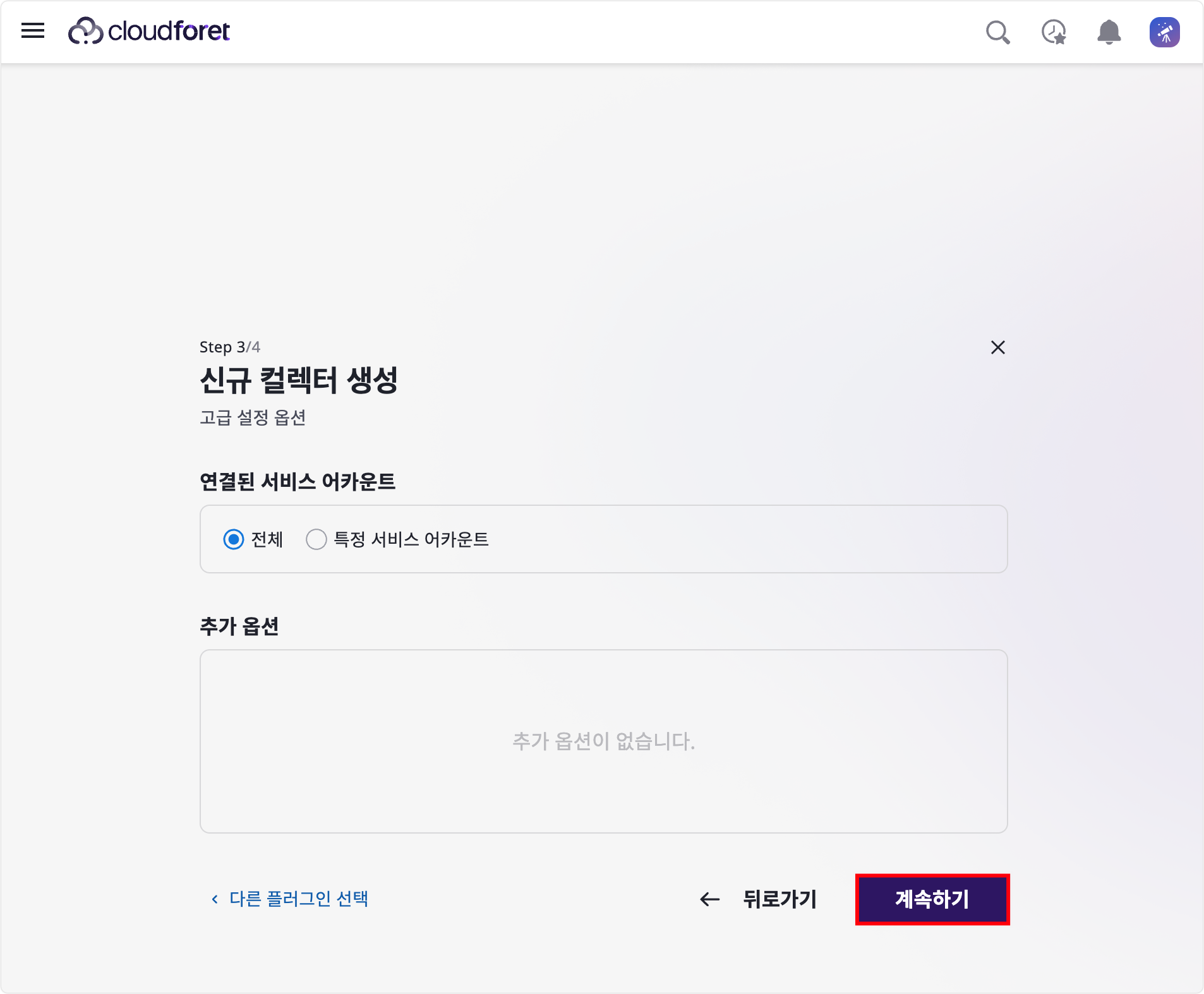
5-7) If you turn on automatic collection scheduling, the collector will automatically collect data at the time you want. Click [New Collector Creation] to collect data.
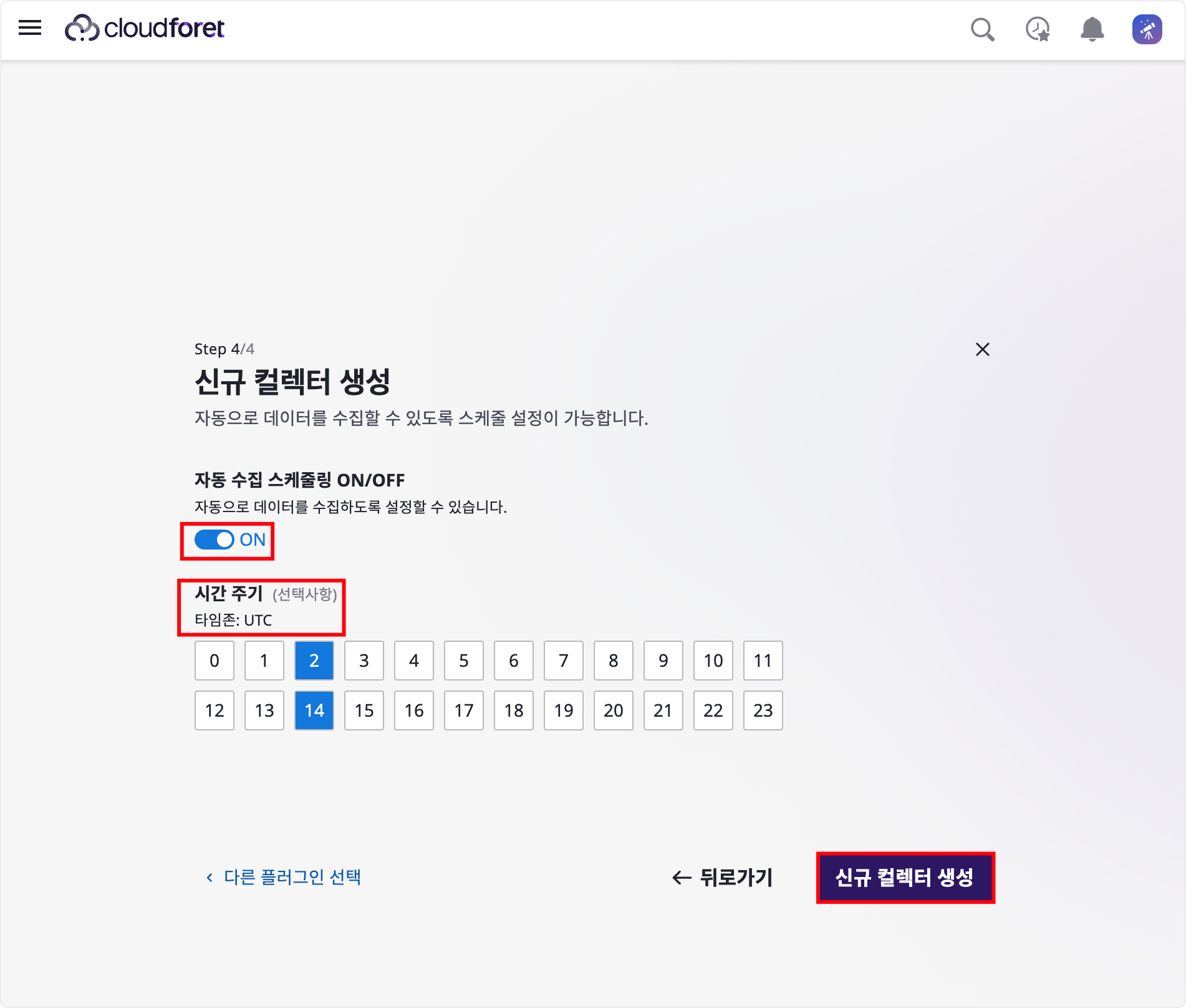

5-8) You can see that the plugin has been added to the cloud service as you specified in provider, cloud_service_group, and cloud_service_type.
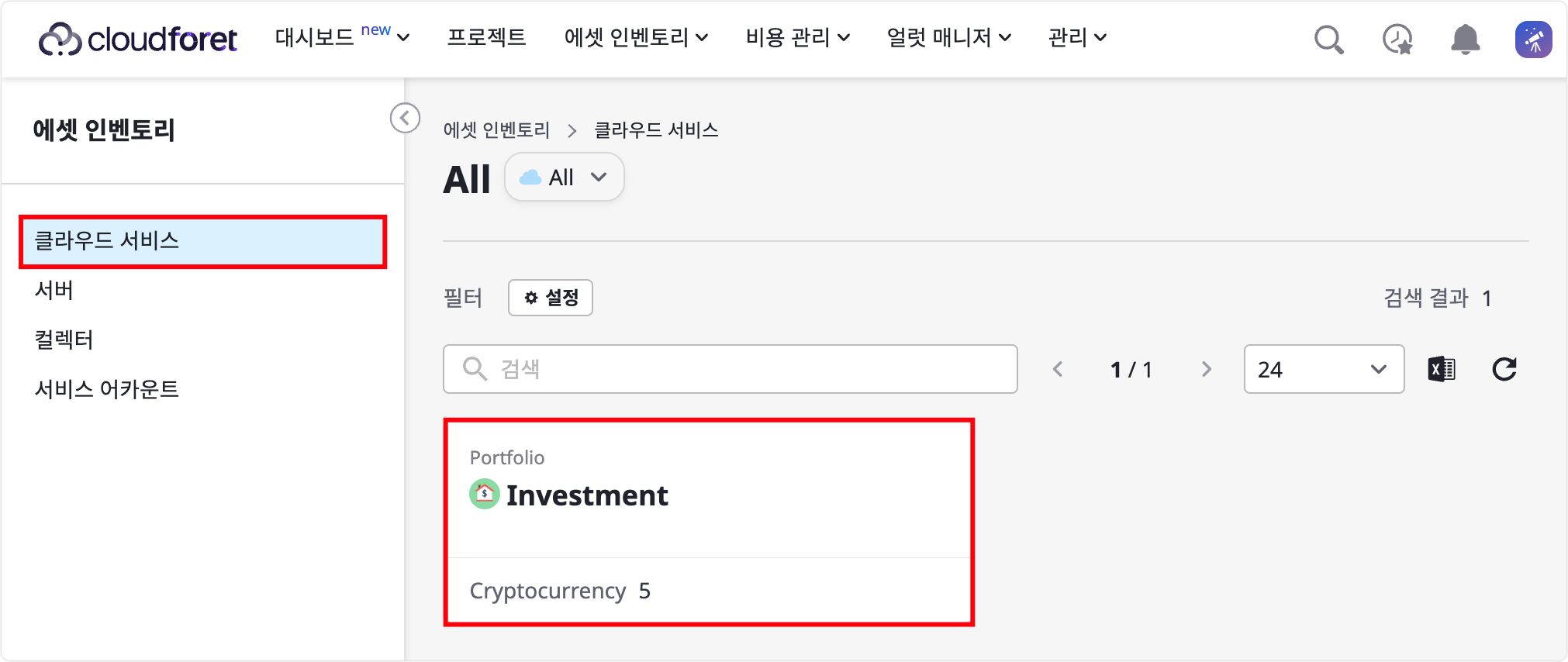
5-9) Since you collected a total of 5 cryptocurrencies, the count is also 5. Click ‘Portfolio’ to see what cryptocurrencies are there.
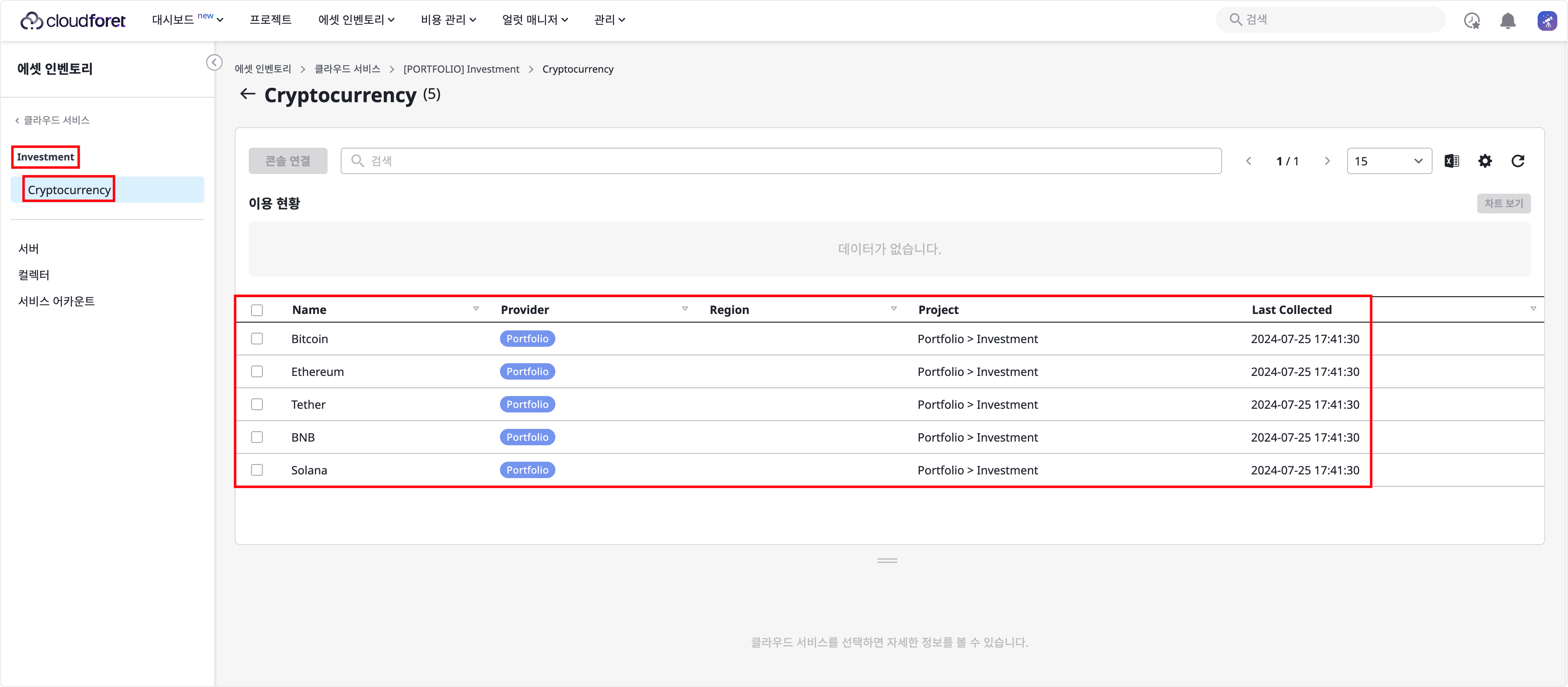
5-10) If you click a specific cryptocurrency, you can see details, tags, etc. in the Details.
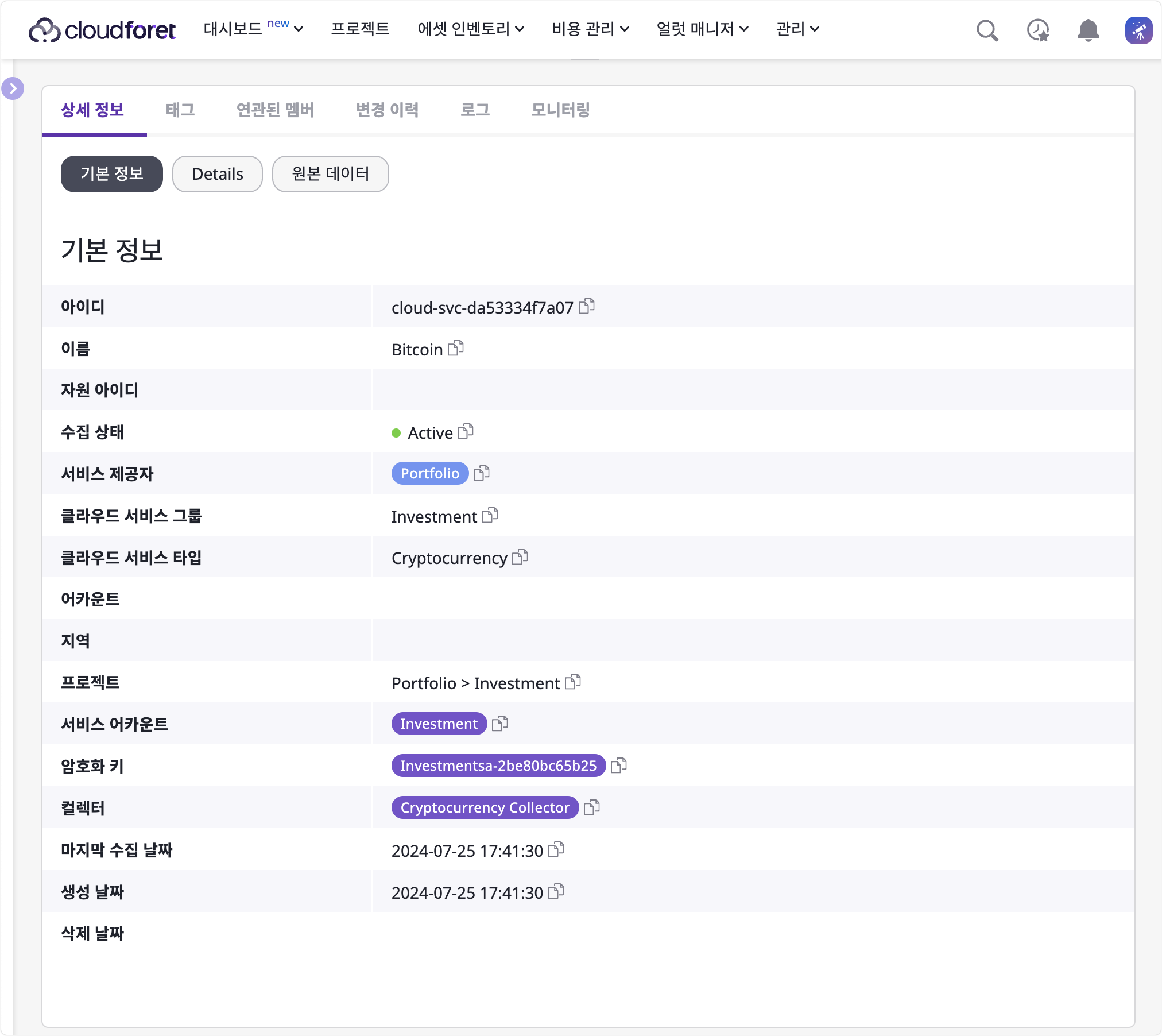
5-11) SpaceONE Dynamic UI Metadata representation result is as follows in Details.
